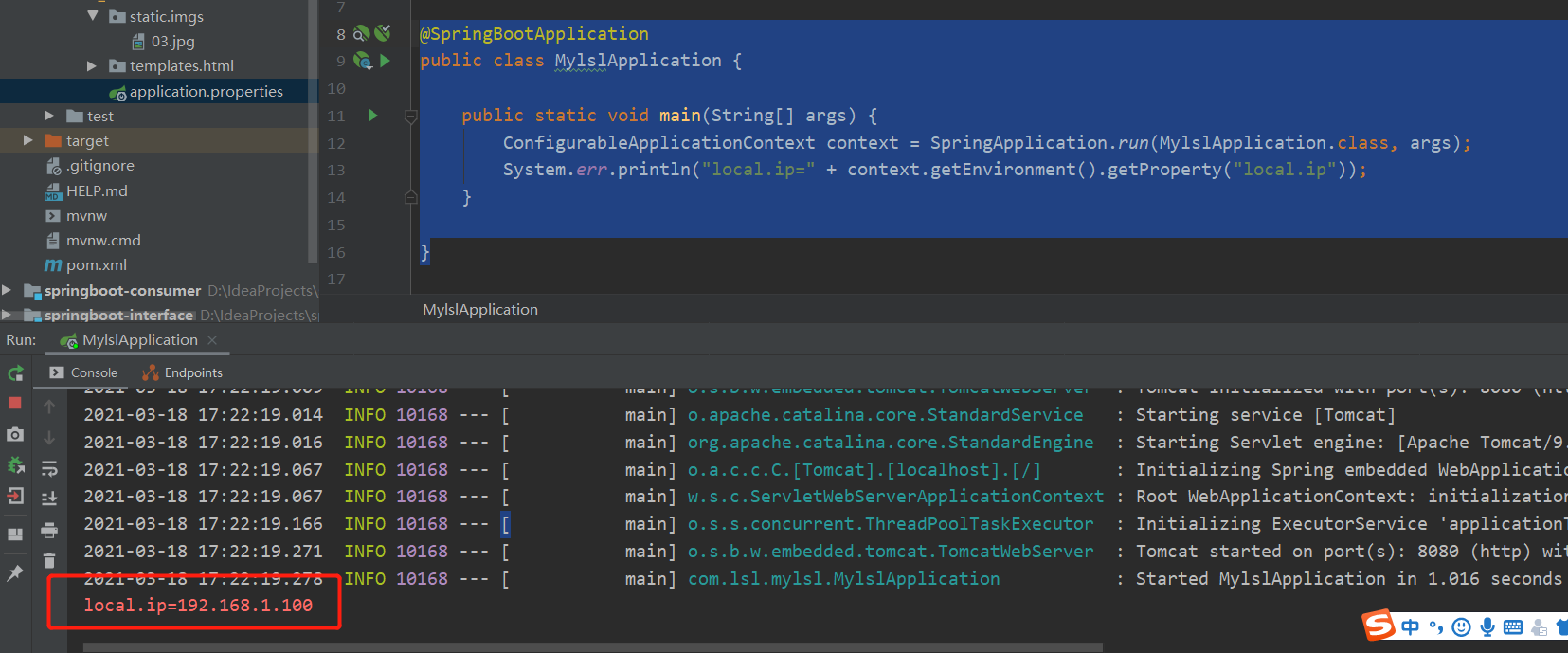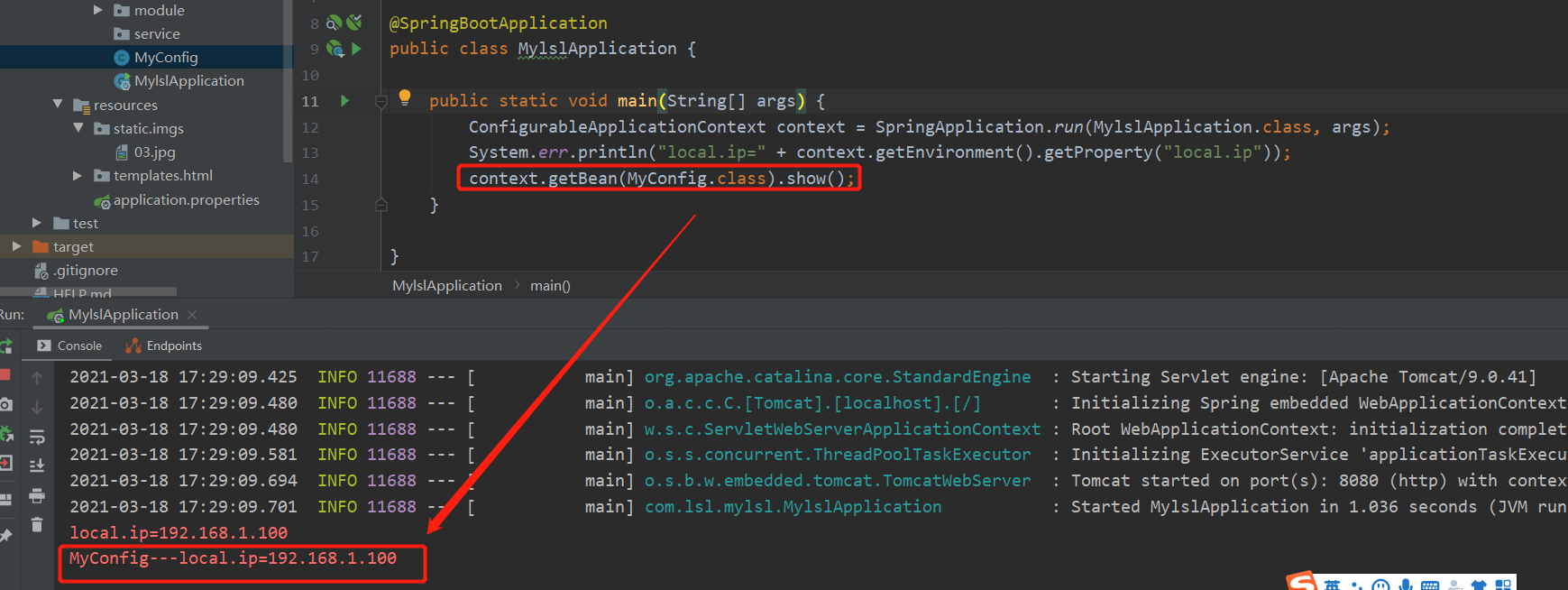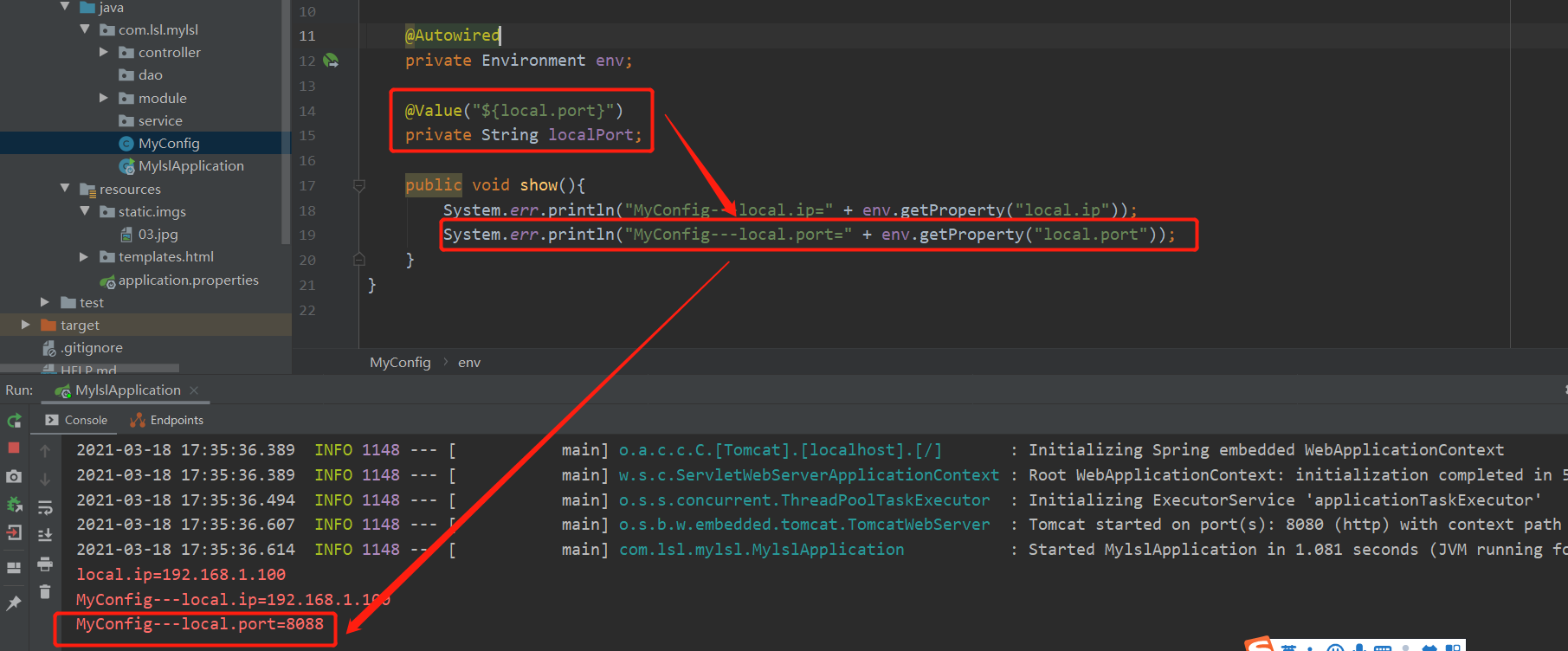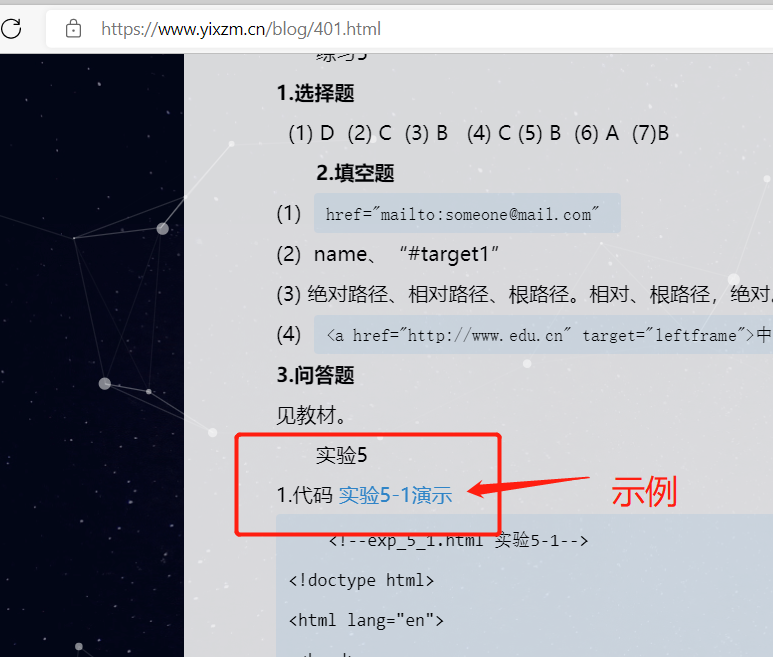springboot获取默认配置文件中的配置项
springboot默认的配置文件是application.properties。如何获取里面的配置项的值呢。
默认配置路径是在classpath根目录【resources】下,或者在classpath:/config目录下
application.properties配置文件中有一下两个配置:
local.ip=192.168.1.100local.port=8088
方式一:在启动类里获取
@SpringBootApplicationpublic class MylslApplication {public static void main(String[] args) {ConfigurableApplicationContext context = SpringApplication.run(MylslApplication.class, args);System.err.println("local.ip=" + context.getEnvironment().getProperty("local.ip"));}}
输出:

方式二:在类中利用Environment获取
新建一个类如下:import org.springframework.beans.factory.annotation.Autowired;import org.springframework.core.env.Environment;import org.springframework.stereotype.Component;@Componentpublic class MyConfig {@Autowiredprivate Environment env;public void show(){System.err.println("MyConfig---local.ip=" + env.getProperty("local.ip"));}}
在启动类里调用下该show()方法,看下打印结果
package com.lsl.mylsl;import org.springframework.boot.SpringApplication;import org.springframework.boot.autoconfigure.SpringBootApplication;import org.springframework.context.ConfigurableApplicationContext;@SpringBootApplicationpublic class MylslApplication {public static void main(String[] args) {ConfigurableApplicationContext context = SpringApplication.run(MylslApplication.class, args);System.err.println("local.ip=" + context.getEnvironment().getProperty("local.ip"));context.getBean(MyConfig.class).show();}}
输出结果:

方式三:在类中利用@Value注解获取,直接赋值给属性
package com.lsl.mylsl;import org.springframework.beans.factory.annotation.Autowired;import org.springframework.beans.factory.annotation.Value;import org.springframework.core.env.Environment;import org.springframework.stereotype.Component;@Componentpublic class MyConfig {@Autowiredprivate Environment env;@Value("${local.port}")private String localPort;public void show(){System.err.println("MyConfig---local.ip=" + env.getProperty("local.ip"));System.err.println("MyConfig---local.port=" + env.getProperty("local.port"));}}
结果输出:

另外,配置文件支持引用配置
local.ip=192.168.1.100local.port=8088name=springbootapp.name=this name ${name}
package com.lsl.mylsl;import org.springframework.beans.factory.annotation.Autowired;import org.springframework.beans.factory.annotation.Value;import org.springframework.core.env.Environment;import org.springframework.stereotype.Component;@Componentpublic class MyConfig {@Autowiredprivate Environment env;@Value("${local.port}")private String localPort;public void show(){System.err.println("MyConfig---local.ip=" + env.getProperty("local.ip"));System.err.println("MyConfig---local.port=" + env.getProperty("local.port"));System.err.println("MyConfig---name=" + env.getProperty("name"));System.err.println("MyConfig---app.name=" + env.getProperty("app.name"));}}
输出结果

默认配置文件及路径的重新指定
配置文件的名字和路径也是可以修改的,通过命令来重新指定
修改文件名字:—spring.config.name=app.properties
修改路径:—spring.config.location=classpath:/conf/app.properties;file /temp/app.properties
/temp/app.properties
修改路径可以是系统文件的,利用file:/来修改。
另外也可以通过编程的方式指定配置文件
比如在classpath:/conf下有个配置文件app.properties
myusername=rootrootpassword=123456

写一个配置类,利用@PropertySource注解引入配置文件


如果需要指定多个配置文件,可以在PropertiesConfig加多个@PropertySource注解
也可以利用@PropertySources注解一次指定多个配置文件
@PropertySources({@PropertySource(“classpath:/conf/app.properties”),@PropertySource(“file:/e:/temp/jdbc.properties”)})
方式四:利用注解@ConfigurationProperties(prefix = “ds”)获取带前缀的配置项
myusername=rootrootpassword=123456ds.url=http://192.168.1.200:8080/index.htmlds.name=LSL
package com.lsl.mylsl;import org.springframework.beans.factory.annotation.Autowired;import org.springframework.beans.factory.annotation.Value;import org.springframework.boot.context.properties.ConfigurationProperties;import org.springframework.core.env.Environment;import org.springframework.stereotype.Component;@Component@ConfigurationProperties(prefix = "ds")public class MyConfig {@Autowiredprivate Environment env;@Value("${local.port}")private String localPort;@Value("${myusername}")private String myusername;@Value("${password}")private String password;private String url;private String name;public void show(){System.err.println("MyConfig---local.ip=" + env.getProperty("local.ip"));System.err.println("MyConfig---local.port=" + env.getProperty("local.port"));System.err.println("MyConfig---name=" + env.getProperty("name"));System.err.println("MyConfig---app.name=" + env.getProperty("app.name"));System.err.println("MyConfig---myusername=" + env.getProperty("myusername"));System.err.println("MyConfig---password=" + env.getProperty("password"));System.err.println("MyConfig---name=" + name + ",url="+url);}public String getUrl() {return url;}public void setUrl(String url) {this.url = url;}public String getName() {return name;}public void setName(String name) {this.name = name;}}
输出结果

对于带前缀的配置项,当然也可以通过上面的方式获取,也可以采用第四种方式获取,属性名必须后配置项后缀名字一致,且注解@ConfigurationProperties(prefix = “ds”)配置好前缀,且配置类里有setter\getter方法,这样才可以。
最后说下,如果获取配置文件中配置项集合
yusername=rootrootpassword=123456ds.url=http://192.168.1.200:8080/index.htmlds.name=LSLds.ports[0]=9000ds.ports[1]=9001ds.ports[2]=9002
package com.lsl.mylsl;import org.springframework.beans.factory.annotation.Autowired;import org.springframework.beans.factory.annotation.Value;import org.springframework.boot.context.properties.ConfigurationProperties;import org.springframework.core.env.Environment;import org.springframework.stereotype.Component;import java.util.ArrayList;import java.util.List;@Component@ConfigurationProperties(prefix = "ds")public class MyConfig {@Autowiredprivate Environment env;@Value("${local.port}")private String localPort;@Value("${myusername}")private String myusername;@Value("${password}")private String password;private String url;private String name;//注入listprivate List<String> ports = new ArrayList<>();public void show(){System.err.println("MyConfig---local.ip=" + env.getProperty("local.ip"));System.err.println("MyConfig---local.port=" + env.getProperty("local.port"));System.err.println("MyConfig---name=" + env.getProperty("name"));System.err.println("MyConfig---app.name=" + env.getProperty("app.name"));System.err.println("MyConfig---myusername=" + env.getProperty("myusername"));System.err.println("MyConfig---password=" + env.getProperty("password"));System.err.println("MyConfig---name=" + name + ",url="+url);System.err.println("MyConfig---ports=" + ports );}public List<String> getPorts() {return ports;}public void setPorts(List<String> ports) {this.ports = ports;}public String getUrl() {return url;}public void setUrl(String url) {this.url = url;}public String getName() {return name;}public void setName(String name) {this.name = name;}}
输出结果




































还没有评论,来说两句吧...